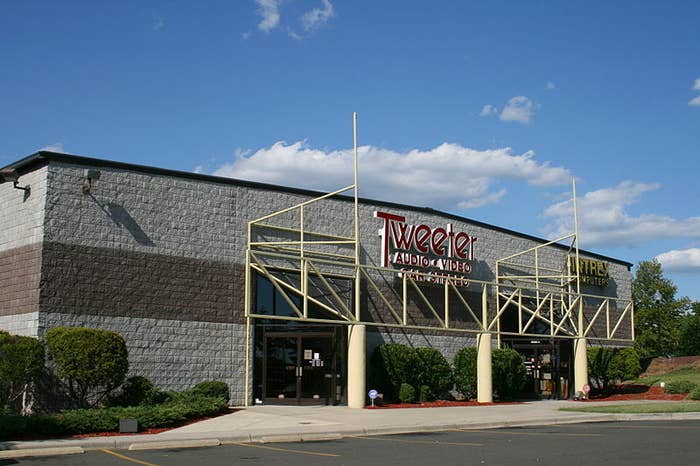
This story, along with about five other versions of it, went viral today:
Tweeter's stock closed yesterday at 1 cent, and opened today at 2 cents, already an impressive 100 percent boost. But by 7:30 a.m. PT, the shares had risen to 15 cents as investors, presumably confused, tried to buy Twitter shares."Twitter-hungry investors rush to wrong Tweet shares," read a headline at CNN Money. This was also cited by FINRA in its official freeze on TWTRQ securities, posted this afternoon, which said it "believed" the activity demonstrated "widespread misunderstanding."
This isn't impossible. But it's only the most appealing, and funniest, of a host of possibilities — and there are reasons to believe that the forces that drove shares of Tweeter Home Entertainment Group, an electronics retailer that filed for bankruptcy years ago, weren't clueless at all.
Howard Lindzon, the CEO of StockTwits, suggested one possibility. "It's an email scam, probably," said Lindzon. Some "smart scumbag," Lindzon said, could have bought some shares and sent out some kind of email blast — email lists are big in the penny stock world, for reasons both practical and illicit — suggesting that the TWTRQ stock would move when the IPO filing was announced.
Bob Wilcox, "The Penny Stock Guru," shared with his readers a MarketWatch story that suggested confusion was behind the price jump, but summarized it with a theory of his own: "TWITTER to IPO via a bankrupt, default penny stock shell? That was the thought behind an over 1,000% early morning rally in $TWTRQ." A Q at the end of a OTC stock ticker symbol usually means that the company is bankrupt. One can imagine a convincing email newsletter, sent with the intention of boosting a stock, concocting some sort of connection between the two, or suggesting that Twitter would somehow need to interact with TWTRQ in order to start trading as TWTR.
Brett Eversole, an analyst at Stansberry Research, said that simple ticker symbol confusion was possible, but admits the whole thing feels odd. "This company has about a million dollars in market value... if you have 10,000 confused people who accidentally put $1,000 in this company, that's $10,000,000. If you have a company that isn't even traded on an exchange — the market makers simply can't handle that, and they skyrocket the price."
But, he says, there are hurdles to making trades like this. "Most brokerage houses, if you want to make an order on an over the counter stock — there's almost always an associated fee with that. So if you're paying $7 for an equity trade, it might cost $50 to buy an over the counter stock. You would assume that would be a flag to investors, but not necessarily."
The most convincing evidence that TWTRQ buyers were in on the joke? When Twitter announced its IPO via a tweet earlier this month, trading volume shot up in a similar way. It fell back down, but trading volume remained much higher than normal until all the way up until today's spike. This information was available to anyone who cared to look for it.

Whether these people were confused or felt like they had some kind of inside angle is immaterial — they were buying and trading TWTRQ. If TWTRQ responded to that initial, information-free tweet, multiplying investments many times over, one might reasonable expect it to respond in a similar way when Twitter's IPO filing was made public.
We’ve confidentially submitted an S-1 to the SEC for a planned IPO. This Tweet does not constitute an offer of any securities for sale.

We’ve confidentially submitted an S-1 to the SEC for a planned IPO. This Tweet does not constitute an offer of any securities for sale.
The volume over the last two weeks was about ten times higher than normal, says Eversole — there was room for something to execute some kind of scheme, if that's what happened. A mere $1,000 investment during this period could have resulted in a nearly $8,000 sale price. (Though it's worth noting that any scam, in this context, would be a relatively small one.)
"If you were talking about a completely unsavvy investor, you would assume they're watching the news, they saw this, and they put an order in at 7 o'clock last night," says Eversole. "And when the market maker shows up in the morning to a million orders in shares, they gap it up. But that didn't happen."
"Volume was very high at open, but it actually peaked at around 11 o'clock. It's curious how the volume shook out during the day," he says. "I'm not sure what you can deduce from this, but it's not what you'd expect if 10,000 confused people put in orders last night."
So here's a version of the story that's been told today, adjusted for cynicism (or optimism, I suppose, if you're a devoted cynic): Perhaps penny stock enthusiasts assumed there would be enough clueless people making the TWTRQ/TWTR mistake to cause a price jump, and decided to get in on the action. Consider this tweet, which was posted yesterday evening.
$TWTRQ, a penny stock, might jump up immensely when confused investors fat finger the wrong ticker for $TWTR so $TWTRQ might get lucky.

NFSS
@ninefoursixsix
$TWTRQ, a penny stock, might jump up immensely when confused investors fat finger the wrong ticker for $TWTR so $TWTRQ might get lucky.
The stock's volume and price were low enough that their scheming alone could explain what happened today.
